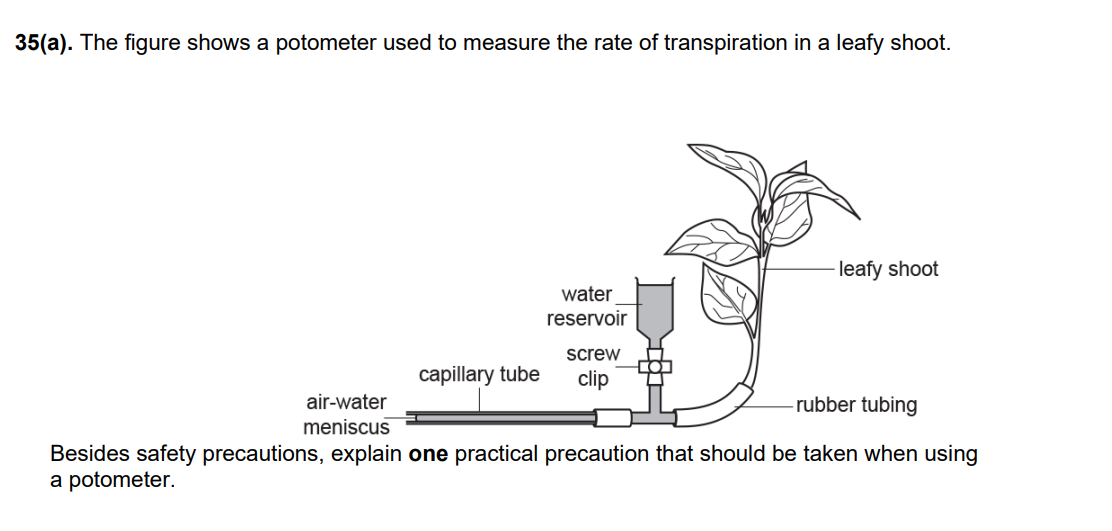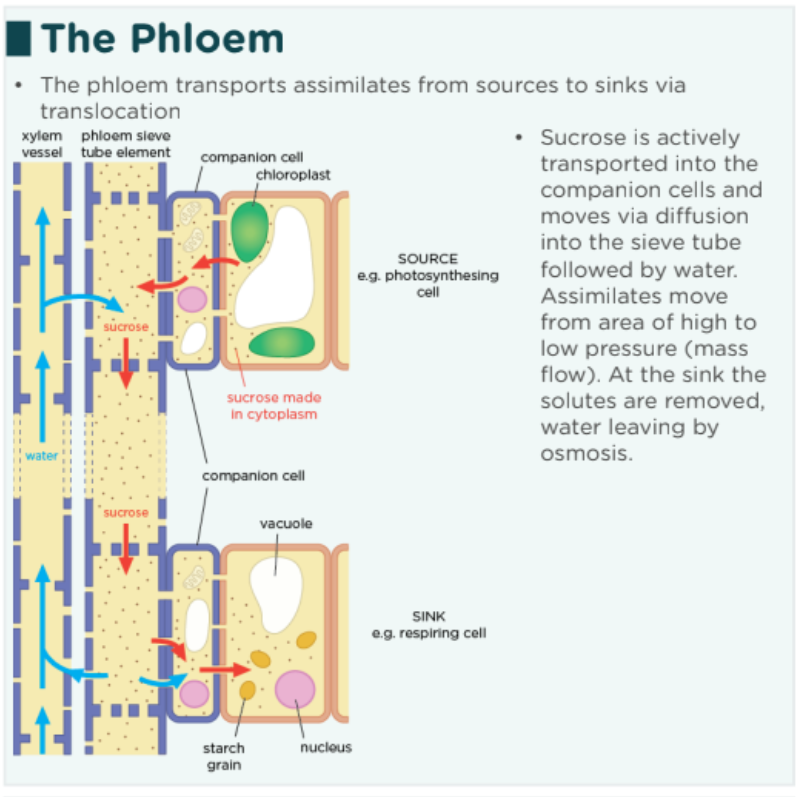TRANSPORT IN PLANTS
1/14
There's no tags or description
Looks like no tags are added yet.
Name | Mastery | Learn | Test | Matching | Spaced |
|---|
No study sessions yet.
15 Terms
Explain how the properties of water are related to the transport role of water in a stem.
cohesion holds water molecules tgt
allows chain of molecules to be pulled up xylem
adhesion allows water mol to stick to xylem vessel walls
by capillary action
solvent to dissolve sucrose/ transport in phloem
what do transport systems in plants transport
transport , water / ions , from roots to , cells / other parts of the plant ✓ 5 (to) transport , sucrose / products of photosynthesis / (named) assimilates , from , source to sink ✓ 6 (to) transport (named) hormones produced in one part to site of action
Sodium chloride in solution dissociates into Na+ and Cl−. Explain how the Casparian strip prevents these ions from reaching the xylem of the plant by the apoplast pathway.
Casparian strip is impervious to water
forces water/ solution to go through cell membrane
phospholipid bilayer repels ions
Give similarity between xylem & phloem structure.
xylem vessels & phloem sieve tube elements lack nuclei/ contents
both made up of cells joined end to end
State differences between xylem & phloem structure.
Phloem has, unlike xylem:
cytoplasm
some organelles
sieve tube elements
companion cells
smaller lumen
sieve plates
Xylem has, unlike phloem:
wider lumen
lignified cell walls
pits
vessels
State the function of the pits in xylem tissue.
lateral movement of water

1) precaution for potometer and explain
2) give rest of method
1)
assemble/ cut shoot under water→ prevent air entering
→ prevent airlock forming
→ prevent air entering & blocking xylem
check apparatus is airtight & watertight
keep abiotic factor (e.g. humidity) constant→ since wld affect transpiration rate
keep screw clip closed→ prevent water entering while measuring
open end of stem in water→ prevent new air bubbles entering
DURING EXPERIMENT
keep shoot still→ measure distance accurately
use syringe to move air bubble→ prevent entering xylem
2)
dry leaves
measure distance air bubble travels per (named) time interval
calculate volume of water uptake
ref. maintaining (named) constant conditions
Given 2 leaves w/ different surface areas. Describe how the student could ensure that a valid comparison could be made between the two leafy shoots.
find/ account for leaf area
find transpiration rate per unit area
reasons for anomalously high distance moved by air bubble.
misread distance
air movement/ light intensity/ temperature increased or humidity decreased
timed for longer than given interval
bubble not returned to starting position
terrarium can be sealed and the plants will be able to grow for months or even years despite not being in contact with the outside atmosphere. Suggest one reason why the plants in a sealed terrarium continue to grow
respiration produces CO2 and H2O which is used in photosynthesis
photosynthesis produces O2 which is used in respiration
decomposition replaces nutrients
Explain how glucose produced in photosynthesis is translocated to parts of the plant where glucose is metabolised or stored.
PHLOEM LOADING
glucose converted into assimilate/ sucrose in photosynthesising cells
apoplast route
active process
protein pump in companion cell membrane
H+ ion concentration gradient
co-transport of H+ and sucrose into companion cell
active transport of sucrose
structural adaptations of companion cell e.g.
many mitochondria (to provide ATP for active transport)
large surface area of cell membrane
passive loading into sieve tube elements via symplast route
diffusion through plasmodesmata
sucrose being actively loaded into sieve tube element decreases its water potential
→ water enters phloem by osmosis from xylem/ surrounding cells
→ increasing hydrostatic pressure at source end
MASS FLOW
hydrostatic pressure gradient from source to sink
→ transport of sucrose from source to sink
PHLOEM UNLOADING
diffusion of sucrose from phloem to surrounding cells
wherever cells need sucrose/ glucose
→ increases water potential of phloem
→ water leaves phloem into xylem by osmosis
→ decreasing hydrostatic pressure
sucrose → glucose → respiration
glucose→ starch for storage
concentration gradient maintained between phloem & cells at sink end

Suggest why it is beneficial to the plant for the carbohydrate to be transferred throughout the plant in the form of sucrose rather than as an alternative carbohydrate.
sucrose is more soluble so can be transported in sap
DO NOT MENTION IF Q SPECIFIES WHY NOT GLUCOSE
sucrose is metabolically inactive so doesn’t get used (e.g. in respiration) during transport
loading / unloading controlled/ uses transport proteins
less likely to exit (sieve tubes)
How is transport in the phloem similar to transport in the xylem?
both carry mineral salts
solutes carried in solution
both use mass flow/ generated hydrostatic pressure
How is transport in the phloem different from transport in the xylem?
phloem carries carbohydrates
transport in phloem can take place in both directions whereas transport in xylem can only take place up plant
phloem uses living cells
xylem uses capillary action/ cohesion & adhesion
Explain, with a suitable example, how some parts of the plant can act as both a ‘source’ and a ‘sink’.
some parts of plant can store carbohydrates and release when needed
e.g. roots and leaves can be sources and sinks at different times of the year